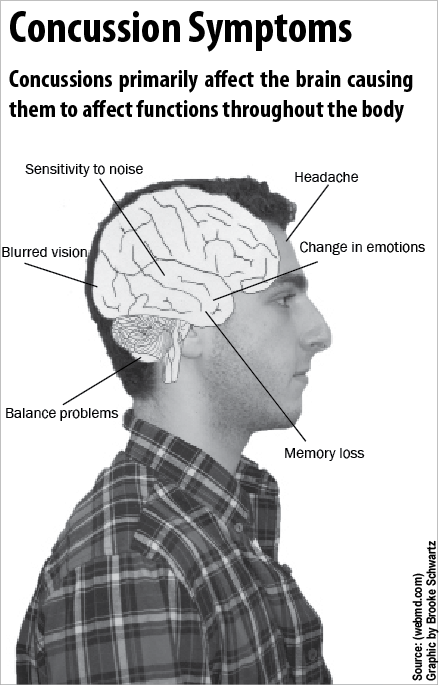Head pounding and tears in her eyes, junior Kylie Meixner sat in math class last spring.

“I looked at a problem and my head hurt so bad,” Meixner said about being handed a worksheet.
At the time, she was experiencing her third concussion and the second one of her sophomore year, all three resulting from soccer-related injuries.
Students downplay symptoms
Meixner said she pushed herself to get back to school because she wanted to be able to take her final exams on time.
According to neuropsychologist Neil McGrath, a common occurrence among athletes is understating symptoms to be able to return to game play or school.
Meixner said she was required to go to the athletic trainer and fill out a concussion screening every day until she recovered. Athletes are asked to assess symptoms such as dizziness, fatigue and irritability on a scale from zero to six. The assessment also surveys students on the amount of time spent on activities like studying and texting.
Sophomore Kayla Fox had two volleyball-related concussions within six months of each other and said that the survey results became inaccurate because she was familiar with them.
“You know what to work on [on the survey],” said Fox. “You know the answer that they’re looking for.”
After her first concussion, Fox said she was out of school for a month and a half. Because it was so hard to catch up on schoolwork, Fox said she rushed to get back to school when she received her second concussion.
Assistant athletic trainer Colleen Lempa said the athletes who play through their concussions or do too much school work have symptoms that tend to linger.
She said symptom screenings are in part what determines whether or not students can return to academics after a concussion. Other tools that the athletic trainers use to measure severity of symptoms are talking to the students, easing back into physical activity, monitoring symptoms daily and working with the doctors.
The worst case of a concussion that Lempa said she has seen involved an athlete who bluffed on his symptom screenings, went back to play and took another hit to the head. He ended up dropping classes and it took him months to recover.
The American Academy of Pediatrics (AAP) published a study, “Returning to Learning Following a Concussion,” on Oct. 27 with updated recommendations about returning to the classroom.
The AAP report suggests taking an individualized approach, but explains that concussion situations can be handled with “similar adjustments,” such as providing frequent breaks or extra time on tests.
The state of Illinois mandates school boards to follow guidelines provided by the IHSA for student athletes with concussions.
However, IHSA guidelines only focus on students returning to sports and have no specific guidelines about returning to the classroom.
Students return to classroom
Lempa said that returning to the classroom really depends on how each student is feeling. The athletic trainers recommend students do a certain amount of schoolwork each day and when they come back the next day, the athletic trainers assess and change their recommendation based on how the students say they are feeling.
“It’s hard to make strict guidelines because there is no exact science on how to treat a concussion,” said Lempa. “You know, things are still too new, too much research is still being done to try and determine how much…academic activity is right.”
One of McGrath’s recommendations is to initially apply the ImPACT test to athletes involved in “high contact sports” like football, soccer, basketball, hockey and lacrosse and eventually require a baseline test for all athletes.
According to McGrath, the ImPACT test measures short term memory, reaction time and general cognitive efficiency.
Fox said that the athletic trainers were unsure how to measure her symptoms when she first got a concussion because she was not required to take a baseline test.
“[Freshman] volleyball players don’t have a baseline and [the athletic trainers] didn’t have anything…to go off of, so it was, like, blind-sided what they were supposed to do about it,” Fox said.
Lempa said that most Glenbrook North athletes will end up taking the baseline ImPACT test and about 80 GBN athletes will get a concussion annually.
“I got to take the test again that I took before, and it was closer to what it was when I didn’t have a concussion like in the beginning of the season, and so then my headaches went away and that’s how I got cleared,” Meixner said about the baseline test that she took.
Schools make improvements in concussion accommodations
The process of identifying and healing concussions has become more organized over the past several years, according to school nurse Mary Beth Manso.
Fox’s father Michael Fox, said coordinating with teachers and the counselor was necessary to help Kayla Fox keep up and catch up with her schoolwork after being out of school for a month and half.
Once Kayla Fox’s counselor brought all her teachers into a room together, it provided a forum for assessment and discussion about her condition and ability to do school work, Michael Fox said.
According to McGrath, teachers paying close attention to the individual and providing school work at the student’s pace is what best allows the student’s recovery to move forward.
Both Meixner and Kayla Fox said that their teachers were understanding. Meixner was excused from certain reading assignments and her teachers let her “do what she could.”
“[Concussions are] very underplayed for how tough it is for the kid,” said Kayla Fox. “And I think if there’s anything that like would need to be improved, it’s the way the teachers handle it. Luckily, I had the greatest teachers.”

